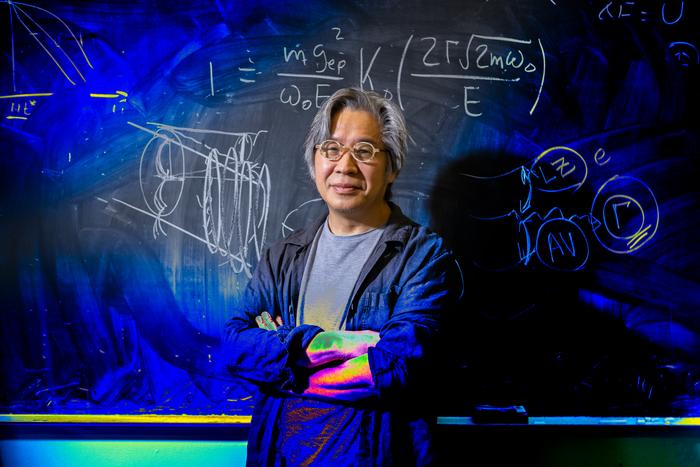BUFFALO, N.Y. — Looking only at their subatomic particles, most materials can be placed into one of two categories.

Credit: Douglas Levere, University at Buffalo
BUFFALO, N.Y. — Looking only at their subatomic particles, most materials can be placed into one of two categories.
Metals — like copper and iron — have free-flowing electrons that allow them to conduct electricity, while insulators — like glass and rubbe r— keep their electrons tightly bound and therefore do not conduct electricity.
Insulators can turn into metals when hit with an intense electric field, offering tantalizing possibilities for microelectronics and supercomputing, but the physics behind this phenomenon called resistive switching is not well understood.
Questions, like how large an electric field is needed, are fiercely debated by scientists, like University at Buffalo condensed matter theorist Jong Han.
“I have been obsessed by that,” he says.
Han, PhD, professor of physics in the College of Arts and Sciences, is the lead author on a study that takes a new approach to answer a long-standing mystery about insulator-to-metal transitions. The study, “Correlated insulator collapse due to quantum avalanche via in-gap ladder states,” was published in May in Nature Communications.
Quantum path allows electrons to move between bands
The difference between metals and insulators lies in quantum mechanical principles, which dictate that electrons are quantum particles and their energy levels come in bands that have forbidden gaps, Han says.
Since the 1930s, the Landau-Zener formula has served as a blueprint for determining the size of electric field needed to push an insulator’s electrons from its lower bands to its upper bands. But experiments in the decades since have shown materials require a much smaller electric field — approximately 1,000 times smaller — than the Landau-Zener formula estimated.
“So, there is a huge discrepancy, and we need to have a better theory,” Han says.
To solve this, Han decided to consider a different question: What happens when electrons already in the upper band of an insulator are pushed?
Han ran a computer simulation of resistive switching that accounted for the presence of electrons in the upper band. It showed that a relatively small electric field could trigger a collapse of the gap between the lower and upper bands, creating a quantum path for the electrons to go up and down between the bands.
To make an analogy, Han says, “Imagine some electrons are moving on a second floor. When the floor is tilted by an electric field, electrons not only begin to move but previously forbidden quantum transitions open up and the very stability of the floor abruptly falls apart, making the electrons on different floors flow up and down.
“Then, the question is no longer how the electrons on the bottom floor jump up, but the stability of higher floors under an electric field.”
This idea helps solve some of the discrepancies in the Landau-Zener formula, Han says. It also provides some clarity to the debate over insulator-to-metal transitions caused by electrons themselves or those caused by extreme heat. Han’s simulation suggests the quantum avalanche is not triggered by heat. However, the full insulator-to-metal transition doesn’t happen until the separate temperatures of the electrons and phonons — quantum vibrations of the crystal’s atoms — equilibrate. This shows that the mechanisms for electronic and thermal switching are not exclusive of each other, Han says, but can instead arise simultaneously.
“So, we have found a way to understand some corner of this whole resistive switching phenomenon,” Han says. “But I think it’s a good starting point.”
Research could improve microelectronics
The study was co-authored by Jonathan Bird, PhD, professor and chair of electrical engineering in UB’s School of Engineering and Applied Sciences, who provided experimental context. His team has been studying the electrical properties of emergent nanomaterials that exhibit novel states at low temperatures, which can teach researchers a lot about the complex physics that govern electrical behavior.
“While our studies are focused on resolving fundamental questions about the physics of new materials, the electrical phenomena that we reveal in these materials could ultimately provide the basis of new microelectronic technologies, such as compact memories for use in data-intensive applications like artificial intelligence,” Bird says.
The research could also be crucial for areas like neuromorphic computing, which tries to emulate the electrical stimulation of the human nervous system. “Our focus, however, is primarily on understanding the fundamental phenomenology,” Bird says.
Other authors include UB physics PhD student Xi Chen; Ishiaka Mansaray, who received a PhD in physics and is now a postdoc at the National Institute of Standards and Technology, and Michael Randle, who received a PhD in electrical engineering and is now a postdoc at the Riken research institute in Japan. Other authors include international researchers representing Swiss Federal Institute of Technology in Lausanne, Pohang University of Science and Technology, and the Center for Theoretical Physics of Complex Systems, Institute for Basic Science.
Since publishing the paper, Han has devised an analytic theory that matches the computer’s calculation well. Still, there’s more for him to investigate, like the exact conditions needed for a quantum avalanche to happen.
“Somebody, an experimentalist, is going to ask me, ‘Why didn’t I see that before?’” Han says. “Some might have seen it, some might not have. We have a lot of work ahead of us to sort it out.”
Journal
Nature Communications
DOI
10.1038/s41467-023-38557-8
Method of Research
Computational simulation/modeling
Subject of Research
Not applicable
Article Title
Correlated insulator collapse due to quantum avalanche via in-gap ladder states
Article Publication Date
22-May-2023





